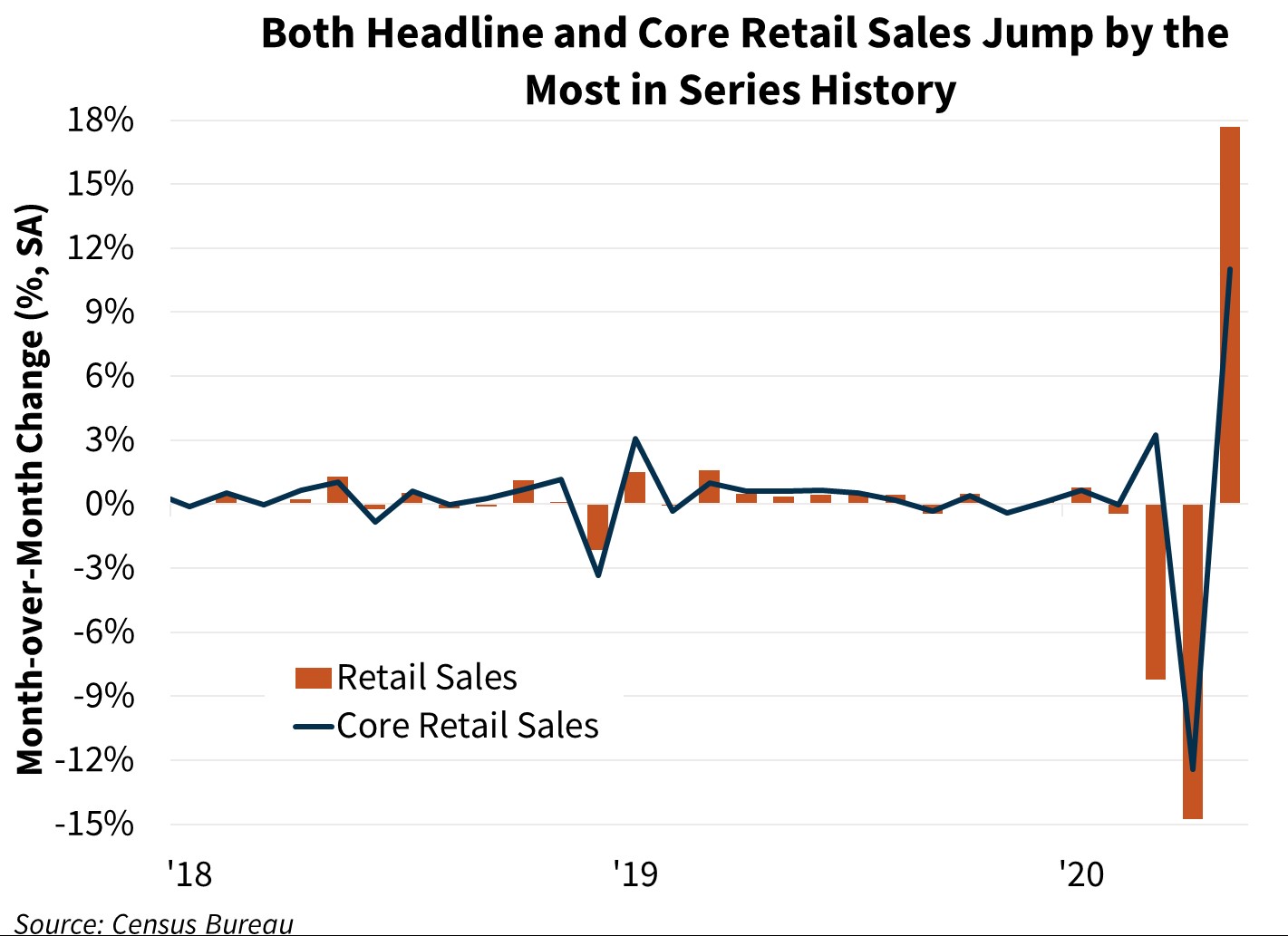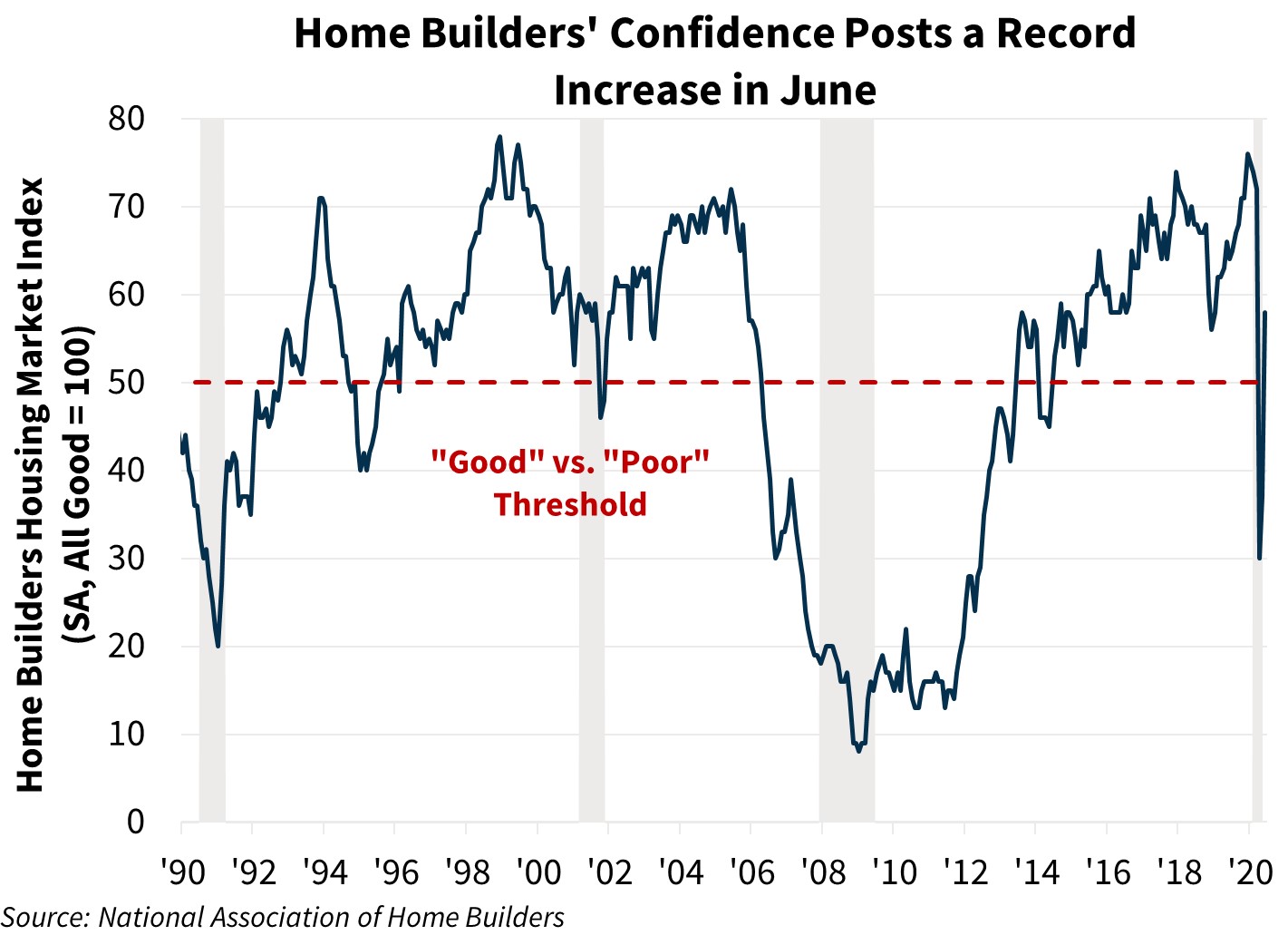Retail Sales Partially Bounce Back as the Economy Reopens
Key Takeaways:
- Retail sales and food services rebounded in May from the steep declines seen in March and April, recovering almost two-thirds of the previous months’ declines, according to the Census Bureau. Motor vehicle sales jumped 44.1 percent and sales at gas stations rose 12.8 percent. Sales at building supply stores jumped 10.9 percent, a positive sign for residential fixed investment. Core retail sales (excluding food services, auto, building supplies, and gas stations) rose 11.0 percent, the largest increase in series history. This was driven by large increases in sales at clothing stores, nonstore retailers, and furniture stores.
- The Conference Board Leading Economic Index (LEI), a gauge of the economic outlook over the next three to six months, increased 2.8 percent in May, a partial recovery from the sharp declines seen over the prior three months. According to the press release, “The relative improvement in unemployment insurance claims is responsible for about two-thirds of the gain in the index.” However, new manufacturing orders and consumers’ outlook on the economy are two measures that continue to suggest weaker economic conditions.
- Industrial production, a gauge of output in the manufacturing, utility, and mining sectors, rose 1.4 percent in May, according to the Federal Reserve Board. This was the first increase since February and the largest increase since October 2017. Manufacturing sector output rose 3.8 percent, driven by an unprecedented surge in motor vehicle production as auto manufacturers reopened previously closed plants. Mining output fell 6.8 percent, the fourth consecutive month of decline, while utilities output fell 2.3 percent.
- The National Association of Home Builders/Wells Fargo Housing Market Index (HMI) jumped by 21 points in June, the largest increase since the series began in 1985. While the index has not recovered to levels seen in March, the indices for current sales, sales over the next six months, and the traffic of prospective buyers all posted solid increases.
- Housing starts in May were somewhat weaker than expected, rising 4.3 percent to a seasonally adjusted annualized rate (SAAR) of 974,000, according to the Census Bureau. This increase was driven almost entirely by a partial rebound in multifamily construction, which jumped 15.0 percent to a SAAR of 299,000. Single-family starts edged up just 0.1 percent to a SAAR of 675,000. The weak single-family number could be a matter of timing, as single-family permits jumped 11.9 percent, the largest increase since February 2009, and single-family units authorized but not yet started rose to the second-highest level since 2008. Regionally, total starts increased in the West and Northeast but fell in the South and Midwest.
- Mortgage applications rose 8.0 percent for the week ending June 12, according to the Mortgage Bankers Association. Purchase applications rose 3.5 percent, the ninth consecutive week of increase. Refinance applications jumped 10.3 percent. From a year ago, purchase and refinance applications were up 20.9 percent and 106.0 percent, respectively.
Forecast Impact
The strong increase in May retail sales is a positive sign for consumer spending as the economy continues to reopen, and it supports our strengthened outlook for personal consumption in the second quarter. However, the boost in May could be partially due to the effect of increased unemployment benefits and stimulus checks provided by the CARES Act. These benefits expire at the end of July, and unless additional legislation is passed to continue them further into the year, the cessation of these benefits and continued high unemployment could lead to a reduction in spending. The negative contribution to the LEI from consumers’ outlook on business activity highlights that there is still uncertainty despite the reopening process. The increase in May industrial production was entirely due to manufacturing activity as factories began the reopening process, which we believe should help boost business investment going forward. In housing, both the increase in new construction in May and the record increase in the homebuilder sentiment in June support our expectation of an increase in housing starts in the third quarter. According to the NAHB press release, “Builders report increasing demand for families seeking single-family homes in inner and outer suburbs that feature lower density neighborhoods,” a sign that the coronavirus may have accelerated a shift in housing preferences. The continued increase in purchase mortgage applications supports the upgrade in our home sales forecast for the second quarter in our recently released June forecast, though we still expect sales to be below their first quarter average.


Economic and Strategic Research Group
June 18, 2020
Opinions, analyses, estimates, forecasts and other views of Fannie Mae's Economic and Strategic Research (ESR) Group included in these materials should not be construed as indicating Fannie Mae's business prospects or expected results, are based on a number of assumptions, and are subject to change without notice. How this information affects Fannie Mae will depend on many factors. Although the ESR group bases its opinions, analyses, estimates, forecasts and other views on information it considers reliable, it does not guarantee that the information provided in these materials is accurate, current or suitable for any particular purpose. Changes in the assumptions or the information underlying these views, including assumptions about the duration and magnitude of shutdowns and social distancing, could produce materially different results. The analyses, opinions, estimates, forecasts and other views published by the ESR group represent the views of that group as of the date indicated and do not necessarily represent the views of Fannie Mae or its management.
